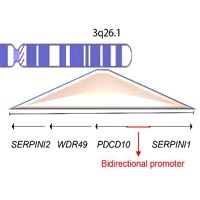Absence of mutations at SERPINI1 gene in a cohort of patients with Cerebral Cavernous Malformations

Accepted: August 21, 2021
All claims expressed in this article are solely those of the authors and do not necessarily represent those of their affiliated organizations, or those of the publisher, the editors and the reviewers. Any product that may be evaluated in this article or claim that may be made by its manufacturer is not guaranteed or endorsed by the publisher.
Cerebral Cavernous Malformations (CCM) are vascular lesions affecting brain microvessels. While molecular bases of the sporadic condition are not yet well elucidated, familial forms arise following mutations at three different loci KRIT1, CCM2 and PDCD10. However, no germline mutations are detected in a small percentage of families with hereditary history of CCM. In order to detect other possible candidate genes, we performed molecular analysis of SERPINI1 gene in a cohort of patients carrying no mutations in the three CCM loci, aiming to detect mutations likely associated to lesion development. Therefore, we performed molecular analysis of the SERPINI1 gene in a cohort of 18 unrelated patients affected by both familial and sporadic CCM showing no germline causative mutations. Mutational analysis resulted negative and only few single nucleotide polymorphisms were detected. However, the rs11284733 SNP was detected in a high percentage of patients affected by familial form of the disease. This SNP occurs within a noncoding exon retained in an alternative spliced SERPINI1 transcript, suggesting its possible role in gene expression regulation.
Flemming KD. Incidence, prevalence, and clinical presentation of Cerebral Cavernous Malformations. Methods Mol Biol 2020;2152:27-33. DOI: https://doi.org/10.1007/978-1-0716-0640-7_2
Wei S, Li Y, Polster SP, et al. Cerebral Cavernous Malformation proteins in barrier maintenance and regulation. Int J Mol Sci 2020;21:675. DOI: https://doi.org/10.3390/ijms21020675
Vercelli GG, Cofano F, Santonio FV, et al. Natural history, clinical, and surgical management of Cavernous Malformations. Methods Mol Biol 2020;2152:35-46. DOI: https://doi.org/10.1007/978-1-0716-0640-7_3
Scimone C, Bramanti P, Ruggeri A, et al. Detection of novel mutation in CCM3 causes familial Cerebral Cavernous Malformations. J Mol Neurosci 2015;57:400-3. DOI: https://doi.org/10.1007/s12031-015-0606-6
Scimone C, Donato L, Katsarou Z, et al. Two novel KRIT1 and CCM2 mutations in patients affected by Cerebral Cavernous Malformations: new information on CCM2 penetrance. Front Neurol 2018;9:953. DOI: https://doi.org/10.3389/fneur.2018.00953
Wang K, Zhou HJ, Wang M. CCM3 and Cerebral Cavernous Malformation disease. Stroke Vasc Neurol 2019;4:67-70. DOI: https://doi.org/10.1136/svn-2018-000195
Johnson AM, Roach JP, Hu A, et al. Connexin 43 gap junctions contribute to brain endothelial barrier hyperpermeability in familial Cerebral Cavernous Malformations type III by modulating tight junction structure. FASEB J 2018;32:2615-29. DOI: https://doi.org/10.1096/fj.201700699R
Dejana E, Orsenigo F. Endothelial adherens junctions at a glance. J Cell Sci 2013;126:2545-49. DOI: https://doi.org/10.1242/jcs.124529
Zhu Y, Wu Q, Fass M, et al. In vitro characterization of the angiogenic phenotype and genotype of the endothelia derived from sporadic Cerebral Cavernous Malformations. Neurosurgery 2011;69:722-31. DOI: https://doi.org/10.1227/NEU.0b013e318219569f
Amelina IP, Solovieva EY. Oxidative stress and inflammation as links in a chain in patients with chronic cerebrovascular diseases. Zh Nevrol Psikhiatr Im S S Korsakova 2019;119:106-14. DOI: https://doi.org/10.17116/jnevro2019119041106
Rinaldi C, Bramanti P, Famà A, et al. Glyoxalase I A111E, paraoxonase I Q192R and L55M polymorphisms in Italian patients with sporadic Cerebral Cavernous Malformations: a pilot study. J Biol Regul Homeost Agents 2015;29:493-500.
Rinaldi C, Bramanti P, Scimone C, et al. Relevance of CCM gene polymorphisms for clinical management of sporadic Cerebral Cavernous Malformations. J Neurol Sci 2017;380:31-7. DOI: https://doi.org/10.1016/j.jns.2017.06.043
Riolo G, Ricci C, Battistini S. Molecular genetic features of Cerebral Cavernous Malformations (CCM) patients: an overall view from genes to endothelial cells. Cells 2021;10:704. DOI: https://doi.org/10.3390/cells10030704
Liquori CL, Berg MJ, Squitieri F, et al. Low frequency of PDCD10 mutations in a panel of CCM3 probands: potential for a fourth CCM locus. Hum Mutat 2006;27:118. DOI: https://doi.org/10.1002/humu.9389
Chen PY, Chang WS, Chou RH, et al. Two non-homologous brain diseases-related genes, SERPINI1 and PDCD10, are tightly linked by an asymmetric bidirectional promoter in an evolutionarily conserved manner. BMC Mol Biol 2007;8:2. DOI: https://doi.org/10.1186/1471-2199-8-2
Silverman GA, Bird PI, Carrell RW, et al. The serpins are an expanding superfamily of structurally similar but functionally diverse proteins. Evolution, mechanism of inhibition, novel functions, and a revised nomenclature. J Biol Chem 2001;276:33293-6. DOI: https://doi.org/10.1074/jbc.R100016200
Scimone C, Donato L, Alibrandi S, et al. Transcriptome analysis provides new molecular signatures in sporadic Cerebral Cavernous Malformation endothelial cells. Biochim Biophys Acta Mol Basis Dis 2020;1866:165956. DOI: https://doi.org/10.1016/j.bbadis.2020.165956
Vaser R, Adusumalli S, Leng SN,et al. SIFT missense predictions for genomes. Nat Protoc. 2016 Jan;11(1):1-9. DOI: https://doi.org/10.1038/nprot.2015.123
Steinhaus R, Proft S, Schuelke M, et al. MutationTaster2021. Nucleic Acids Res. 2021 Jul 2;49(W1):W446-W451. DOI: https://doi.org/10.1093/nar/gkab266
Adzhubei IA, Schmidt S, Peshkin L, et al. A method and server for predicting damaging missense mutations. Nat Methods. 2010 Apr;7(4):248-9. DOI: https://doi.org/10.1038/nmeth0410-248
Davis RL, Shrimpton AE, Carrell RW, et al. Association between conformational mutations in neuroserpin and onset and severity of dementia. Lancet 2002;359:2242-7. DOI: https://doi.org/10.1016/S0140-6736(02)09293-0
Ali MF, Kaushik A, Gupta D, et al. Changes in strand 6B and helix B during neuroserpin inhibition: Implication in severity of clinical phenotype. Biochim Biophys Acta Proteins Proteom 2020;1868:140363. DOI: https://doi.org/10.1016/j.bbapap.2020.140363
Scimone C, Bramanti P, Ruggeri A, et al. CCM3/SERPINI1 bidirectional promoter variants in patients with Cerebral Cavernous Malformations: a molecular and functional study. BMC Med Genet 2016;17:74. DOI: https://doi.org/10.1186/s12881-016-0332-0
Scimone C. Possible related functions of the non-homologous co-regulated gene pair PDCD10 and SERPINI1. EMBJ 2017;12:041–6.
Omouendze PL, Henry VJ, Porte B, et al. Hypoxia-ischemia or excitotoxin-induced tissue plasminogen activator- dependent gelatinase activation in mice neonate brain microvessels. PLoS One 2013;8:e71263. DOI: https://doi.org/10.1371/journal.pone.0071263
Maroney SA, Westrick RJ, Cleuren AC, et al. Tissue factor pathway inhibitor is required for cerebrovascular development in mice. Blood 2021;137:258-68. DOI: https://doi.org/10.1182/blood.2020006054
Hu E, Hu W, Yang A, et al. Thrombin promotes pericyte coverage by Tie2 activation in a rat model of intracerebral hemorrhage. Brain Res 2019;1708:58-68. DOI: https://doi.org/10.1016/j.brainres.2018.12.003
PAGEPress has chosen to apply the Creative Commons Attribution NonCommercial 4.0 International License (CC BY-NC 4.0) to all manuscripts to be published.


 https://doi.org/10.4081/jbr.2021.9838
https://doi.org/10.4081/jbr.2021.9838



